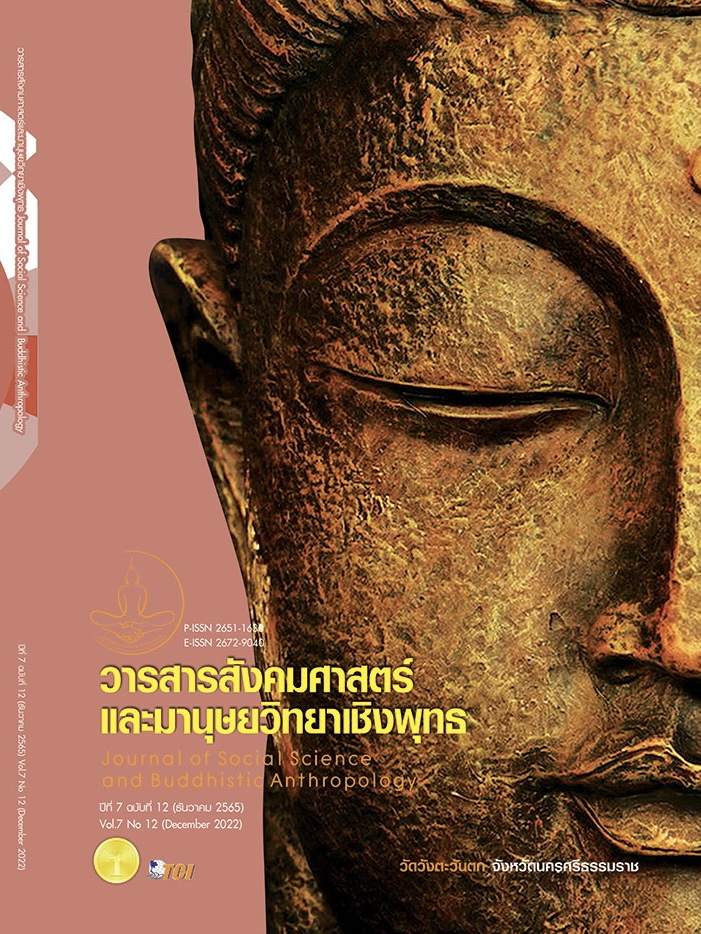THE CREATION OF CONTEMPORARY JEWELRY FROM THE PERMACULTURE IN POOMJAI GARDEN
Keywords:
Permaculture, Contemporary Jewelry, Poomjai GardenAbstract
This research article aims to discover essential permaculture principles in Poomjai Garden and integrate the knowledge with aesthetic value. In order to create pieces and materials for contemporary jewelry, natural resources inside the Poomjai Garden have been used at their maximum capacity. The essential permaculture principles in Poomjai Garden that this qualitative research has discovered are as follows: 1) The maintenance of the old-fashioned lifestyle of lychee gardeners for more than one hundred years is to protect natural resources and preserve original local wisdom, 2) The Integrated Farming creates biological relations and agricultural consumption across the year because each plant is fruitful in different times, 3) The usability of biological resources and waste at their highest possibility and 4) The building of relationships and participation between people in the community. These principles have been integrated with aesthetic philosophy to translate the concept through contemporary jewelry mediums. The study started with creating the material – Agricultural Waste Composite, which reflected the local identity by processing agricultural and plastic wastes in a simple and low-cost way. Afterward, this material was designed into contemporary jewelry emphasizing the aesthetic of natural elements: colors, shapes, and forms representing the connection and fruitful relationship inside the Poomjai Garden. In conclusion, this research has established knowledge in designing and making contemporary jewelry for the environment to encourage people to understand the importance of balancing the life of human beings and nature.
References
ธนภูมิ พุ่มจันทร์. (2562). การพัฒนารูปแบบการเรียนการสอนเศรษฐศาสตร์โดยบูรณาการหลักอริยมรรค เพื่อส่งเสริมคุณลักษณะของนักเรียนตามแนวคิดเศรษฐศาสตร์เชิงพุทธ. ใน ดุษฎีนิพนธ์ปรัชญาดุษฎีบัณฑิต สาขาวิชาหลักสูตรและการสอน. มหาวิทยาลัยศิลปากร.
วิฑูรย์ ปัญญากุล. (2547). เกษตรยั่งยืน : วิถีการเกษตรเพื่ออนาคต. กรุงเทพมหานคร: บริษัทวี พริ้น.
ศูนย์สร้างสรรค์การออกแบบ. (2555). เจาะเทรนด์โลก 2012. เรียกใช้เมื่อ 15 กันยายน 2565 จาก http://resource.tcdc.or.th/ebook/TCDC_TREND2012.pdf
สำนักงานเลขานุการของคณะกรรมการยุทธศาสตร์ชาติ. (2563). ยุทธศาสตร์ชาติด้านการสร้างความสามารถในการแข่งขัน. เรียกใช้เมื่อ 13 สิงหาคม 2565 จาก https://www.nesdc.go.th/download/document/SAC/NS_SumPlanOct2018.pdf
สำนักงานพัฒนาวิทยาศาสตร์และเทคโนโลยีแห่งชาติ. (2564). แผนปฏิบัติการด้านการขับเคลื่อนการพัฒนาประเทศไทยด้วยโมเดลเศรษฐกิจ BCG พ.ศ. 2564-2570. เรียกใช้เมื่อ 19 สิงหาคม 2565 จาก https://waa.inter.nstda.or.th/stks/pub/ bcg/20211228-BCG-Action-Plan-2564-2570.pdf
สำนักงานสภาพัฒนาการเศรษฐกิจและสังคมแห่งชาติสำนักนายกรัฐมนตรี. (2565). ร่างแผนพัฒนาเศรษฐกิจและสังคมแห่งชาติฉบับที่สิบสาม พ.ศ. 2566 - 2570. เรียกใช้เมื่อ 13 ธันวาคม 2565 จาก https://www.nesdc.go.th/download/Plan13/Doc/ Plan13_DraftFinal.pdf
สุภาวี ศิรินคราภรณ์. (2552). แนวทางการพัฒนาเมืองสวยด้วยการสร้างสรรค์งานศิลปวัฒนธรรมร่วมสมัย กรณีศึกษาภูมิปัญญาและวิถีชีวิตแห่งชุมชนบ้านแม่หมีใน จังหวัดลำปาง กับ พัฒนาการการสร้างสรรค์สุนทรียภาพของเครื่องประดับชาติพันธุ์ร่วมสมัย. ใน รายงานการวิจัย. สำนักงานศิลปวัฒนธรรมร่วมสมัย : กระทรวงวัฒนธรรม.
สุวิทย์ วงศ์รุจิราวาณิชย์. (2556). ดีไซน์...เปลี่ยนโลก. กรุงเทพมหานคร: กรุงเทพธุรกิจ.
อาภรณ์ ภูมิพันนา. (2537). เพอร์มาคัลเชอร์ หนทางสู่เกษตรกรรมถาวร. นนทบุรี: ชมรมศิษย์เก่าบูรณะ.
อิทธิพล ตั้งโฉลก. (2550). แนวทางการสอนและสร้างสรรค์จิตรกรรมขั้นสูง. กรุงเทพมหานคร: อมรินทร์พริ้นติ้งแอนด์พับลิชชิ่ง.
Downloads
Published
How to Cite
Issue
Section
License
Copyright (c) 2022 Journal of Social Science and Buddhistic Anthropology

This work is licensed under a Creative Commons Attribution-NonCommercial-NoDerivatives 4.0 International License.








